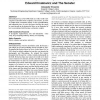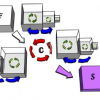485 search results - page 93 / 97 » Classification of Human Body Motion |
ICANN
2010
Springer
13 years 5 months ago
2010
Springer
Trajectory formation is one of the basic functions of the neuromotor controller. In particular, reaching, avoiding, controlling impacts (hitting), drawing, dancing and imitating ar...
BMCBI
2005
13 years 7 months ago
2005
Background: Text mining has spurred huge interest in the domain of biology. The goal of the BioCreAtIvE exercise was to evaluate the performance of current text mining systems. We...
CHI
2004
ACM
14 years 7 months ago
2004
ACM
Facial affect (or emotion) recognition is a central issue for many VMC and naturalistic computing applications. Most computational models assume "categorical perception"...
CANDC
2005
ACM
13 years 9 months ago
2005
ACM
Edward Ihnatowicz (1926-1988) built one of the world’s first computer-controlled robotic sculptures, The Senster, in 196870. Rather than concentrate entirely on this groundbreak...
CVPR
2009
IEEE
15 years 2 months ago
2009
IEEE
Several spatiotemporal feature point detectors have been recently used in video analysis for action recognition. Feature points are detected using a number of measures, namely sali...


